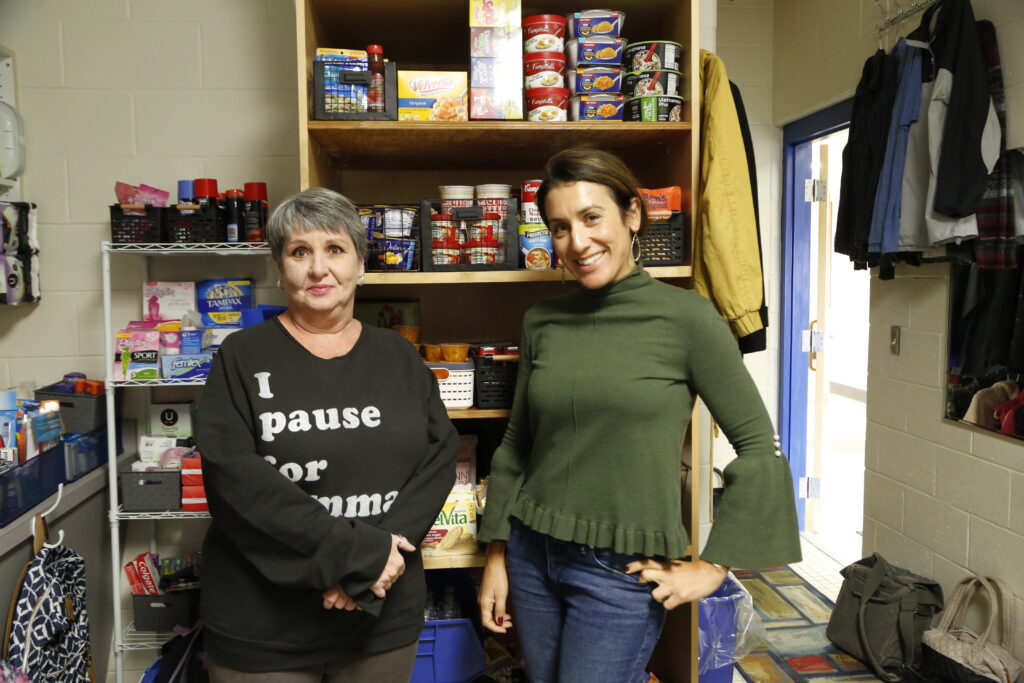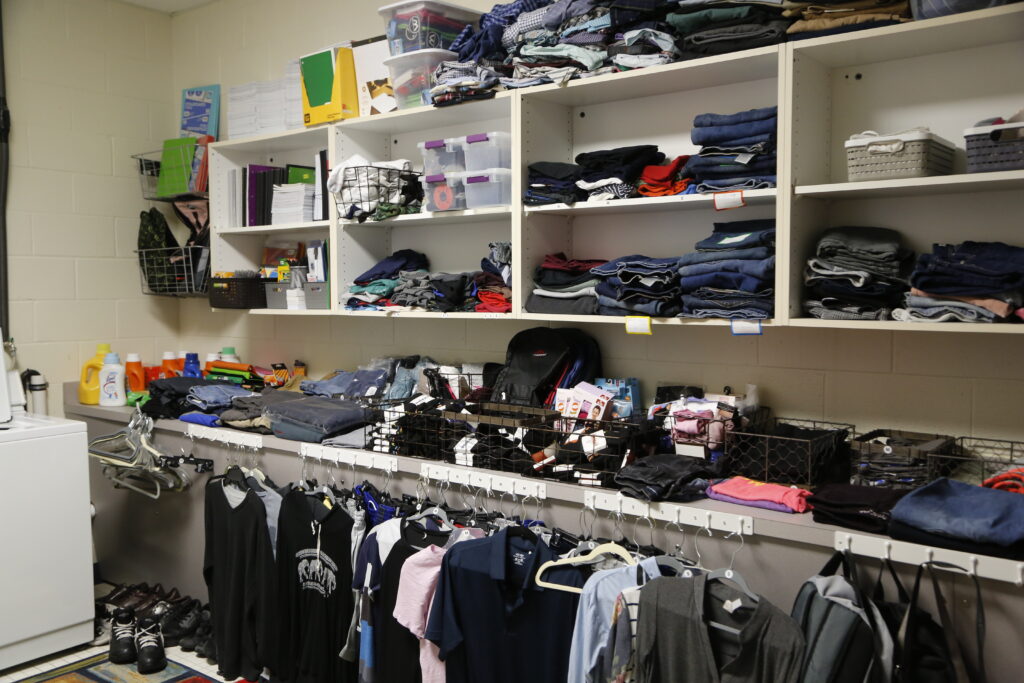By Kathryn Coulibaly
Hammonton High School English teacher Cari Coia “sees” teenagers. She sees the things they are struggling with. She sees the things they would rather hide. She sees their talents and their dreams. She sees their hopes and disappointments. And quietly and kindly, with the help of people who support the Hammonton High School pantry, she gets them what they need.
In 2019, Coia recognized a need for a school pantry at the high school—a place where students could go and “shop” with dignity; where they could get clothes, personal hygiene materials, school supplies, and food when they were in need. She submitted a grant with the Hammonton Education Foundation and was awarded $7,500 to convert a former storage space into a pantry with cabinets, a colorful rug, and a washing machine and dryer.
“I wanted it to be a ‘boutique-y’ looking place,” Coia explained. She hung students’ artwork on the walls and modeled the pantry after something she had seen on TV; a place where the students would want to go.
Coia has reapplied for grants from the Hammonton Education Foundation every year since then and has raised funds from local businesses, staff, and organizations such as the Puerto Rican Civic Association, the Victory Bible Church and the Kiwanis Club. Whatever she can get for her students is quickly disbursed because the need is so great.
“We had a student whose house burned down, and we were able to help them,” Coia said. “Another student was devastated because her family had lost their food stamps, and the pantry helped. Some students are dealing with really challenging home situations. You really can’t imagine the things that some students are struggling with at home. For them, school is a refuge.”
Stocking the pantry
Coia stocks the space with new clothing whenever possible. She chooses things the teenagers will like. She displays the clothing in appealing ways. She wants the teens to feel good about choosing things from the pantry. If money is available, they try to order each student exactly what they need and want.
“Choice is empowering for students who don’t have a lot of choice in their lives,” said Stacy Gerst, an English teacher and member of the Hammonton Education Foundation.
There are shoes and winter coats, hats, gloves, and scarves. Students love when soft blankets are available. There are art supplies and bookbags. Whatever students could need, Coia tries to provide it, but it’s hard to keep up.
“Students are proud and don’t like to be singled out,” Coia said. “When we first started the pantry, its existence spread by word-of-mouth, through the Counseling Department, and by just letting students see the pantry under the guise of ‘helping a teacher restock items.’ Students were recommended by counselors, teachers, and staff members. We tried to pair each student in need with an adult they trusted. Thankfully, we’re at the point now where kids are asking for help.”

Feeding hungry families
Coia’s main challenge now is that the grant money she receives cannot be used on gift cards, and sometimes the best thing to help a student is to give them gift cards to ShopRite or Walmart so their families can purchase what they need, especially food.
“The food that we stock in the pantry is really for students to consume here at school,” Coia said. “Sometimes, a teacher will come down and get some food if they know they’ve got a few students in their next class who will be hungry.”
Like many communities, there are so many families in need, it’s nearly impossible to keep up, especially with the gift cards. The cards are distributed through the Counseling Department, and unfortunately, the supply of cards disappears quickly.
“We don’t give less than $50, and we try to give families what they need. If they need diapers, we try to get them diapers. We are here to help the whole family,” Coia said.
The pantry’s washer and dryer provide an essential service for students who may not have in-home machines, or transportation to laundry facilities.
“It may seem like a little thing, but it can make all the difference in the world for students,” Coia said.
Scholarships recognize motivation
Andrea Streitfeld, a retired HHS teacher who sponsors a scholarship, Coia, and the entire high school staff help to provide the funds for scholarships given students who may not be the top academic achievers, but who work hard and overcome tremendous obstacles in order to graduate high school.
“Two or three years ago, we started giving out a $500 scholarship, and you should see how proud these kids are,” Coia said. “I see how hard it is for them to get to school, keep up with their school work, even stay alert in class with everything they have going on at home. Some of them are shouldering adult burdens at their young age. We wanted to show them that they are seen and respected for the hard work they are putting in to get their educations.”
One of the challenges to fundraising for the pantry is that the need is constant, ever-present and overwhelming. Coia and her colleagues are trying to come up with solutions that would allow them to consistently provide gift cards and necessities to students. Very few of their students are effectively helped with a “one time” offering of assistance.
“If I give the Counseling Department $1,000 in gift cards, they are gone in four days or less,” Coia said. “The cards go to students who really need them; the problem is that there are always more students in need than there are gift cards. And now that the students are willing to ask for help, it is heartbreaking to have to tell them that we simply don’t have what they need at the time.”
A checks and balances system is at work in the pantry. Coia works closely with the head of Counseling Mike Ryan, his counseling team members, the child study team, and other teachers and staff members to ensure that someone is always aware of how every donation and grant dollar is spent. The goal is to help as many students as possible. Any adult at the high school can access the pantry or to ask for assistance for a specific child. The more people who notice a child in need and get them assistance, the better.
The pantry is available whenever students need it, even over the summer. All students or staff need to do is reach out to Coia and she will make sure students can get what they need.
“Schools can be so focused on data and testing, and on the academic parts of high school that we forget that students experiencing trauma or dealing with difficult situations are truly unable to function as learners.” Coia said.
The pantry’s impact has been profound, not just on the Hammonton High School community, but on other schools in the district. The middle and elementary schools have now started their own pantries, and the early childhood education center will soon follow. The middle school staff are envious of the washer and dryer that are available at the high school.

Poverty in New Jersey
Hammonton is not unique in its need. According to the state of New Jersey, 14% of children under the age of five in the state live in poverty, and these numbers are higher for Black and Hispanic children. Atlantic County has one of the highest percentages in the state, with 23% of children under the age of five living in poverty.
According to some analyses, almost one million New Jerseyans are living in poverty post-pandemic. These are just the numbers that can be verified. Keep in mind, the federal poverty level is $20,598. Adjusted for the cost of living in New Jersey, the minimum a family of three needs to earn in order to get by is $74,372. More than three million people in New Jersey are living below this number.
At the same time, government programs intended to help struggling families are falling short of their goals.
“Fewer than one in six families living in poverty are supported by Work First New Jersey, and even those who receive assistance do not get enough to make ends meet,” said Brittany Holom-Trundy, senior policy analyst at New Jersey Policy Perspective, was quoted in the NJ.com article, “N.J. families living in extreme poverty need more help from vital safety net, advocates say.”
Coia and her colleagues in Hammonton are doing what they can to help make a difference for their students and their families. The pantry welcomes any and all help to meet the needs of the students and their families.
Anyone interested in learning more about the pantry can email Coia at ccoia@hammontonps.org.
“Everyone needs help sometimes, especially since COVID.” Coia said. “Make no mistake, investing in these students now will not only yield significant rewards for our community, but will also help our struggling students overcome the obstacles in their way and become the adults they are meant to be. After all, isn’t this why we all are in education?”
Kathryn Coulibaly is the associate editor of the NJEA Review and provides content and support to njea.org. She can be reached at kcoulibaly@njea.org.